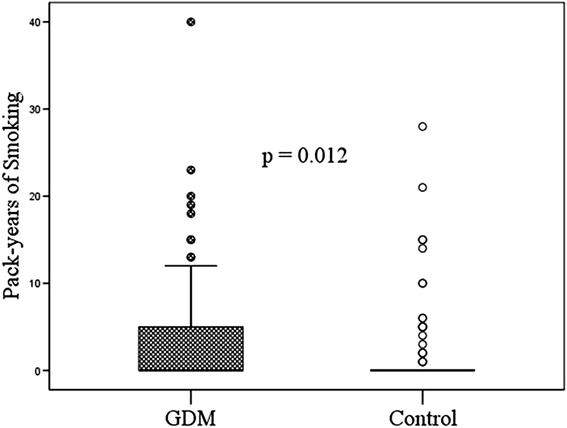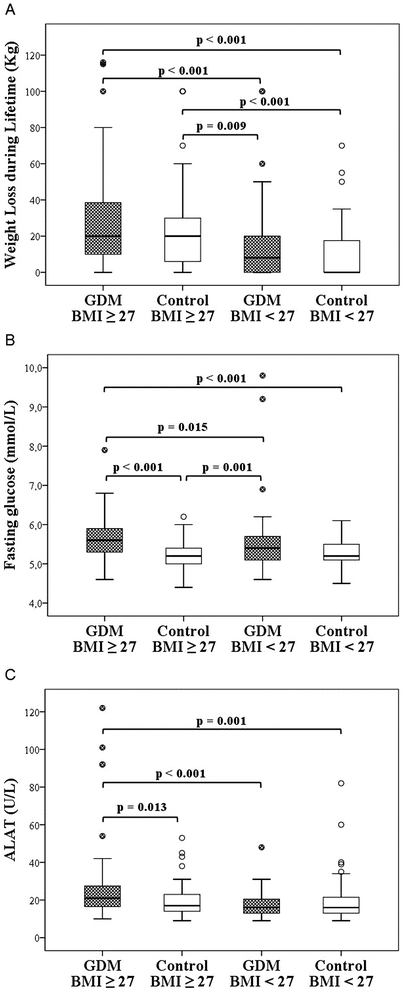The risk of metabolic syndrome after gestational diabetes mellitus - a hospital-based cohort study
- PMID: 26893617
- PMCID: PMC4758091
- DOI: 10.1186/s13098-015-0038-z
The risk of metabolic syndrome after gestational diabetes mellitus - a hospital-based cohort study
Abstract
Background: Women with gestational diabetes mellitus (GDM) are at an increased risk of developing metabolic syndrome (MetS) after delivery. Recently, the prevalence of both GDM and MetS has increased worldwide, in parallel with obesity. We investigated whether the presentation of MetS and its clinical features among women with previous GDM differs from that among those with normal glucose tolerance during pregnancy, and whether excess body weight affects the results.
Methods: This hospital-based study of two cohorts was performed in Kanta-Häme Central Hospital, Finland. 120 women with a history of GDM and 120 women with a history of normal glucose metabolism during pregnancy, all aged between 25 and 46 were enrolled. They all underwent physical examination and had baseline blood samples taken. All 240 women were also included in subgroup analyses to study the effect of excess body weight on the results.
Results: Although the groups did not differ in body mass index (BMI; p = 0.069), the risk of developing MetS after pregnancy complicated by GDM was significantly higher than after normal pregnancy, 19 vs. 8 cases (p = 0.039). Fasting glucose (p < 0.001) and triglyceride levels (p < 0.001) were significantly higher in women affected. In subgroup analysis, cardiovascular risk factors were more common in participants with high BMI than in those with previous gestational diabetes.
Conclusions: The risk of MetS was 2.4-fold higher after GDM than after normal pregnancy. Cardiovascular risk factors were more common in participants with high BMI than in those with previous GDM. Multivariate analysis supported the main findings. Weight control is important in preventing MetS after delivery.
Keywords: Body mass index; Body weight excess; Cardiovascular risk factors; Gestational diabetes mellitus; Metabolic syndrome.
Figures



References
-
- Vuori E, Gissler M. Perinatal statistics: parturients, deliveries and newborns 2013 statistical report 23/2014. Helsinki: National Institute for Health and Welfare; 2014.
-
- Dabelea D, Snell-Bergeon JK, Hartsfield CL, Bischoff KJ, Hamman RF, McDuffie RS. Kaiser Permanente of Colorado GDM screening program: increasing prevalence of gestational diabetes mellitus (GDM) over time and by birth cohort: Kaiser Permanente of Colorado GDM screening program. Diabetes Care. 2005;28(3):579–84. doi: 10.2337/diacare.28.3.579. - DOI - PubMed
-
- Järvelä IY, Juutinen J, Koskela P, Hartikainen AL, Kulmala P, Knip M, et al. Gestational diabetes identifies women at risk for permanent type 1 and type 2 diabetes in fertile age: predictive role of autoantibodies. Diabetes Care. 2006;29(3):607–12. doi: 10.2337/diacare.29.03.06.dc05-1118. - DOI - PubMed
LinkOut - more resources
Full Text Sources
Other Literature Sources

